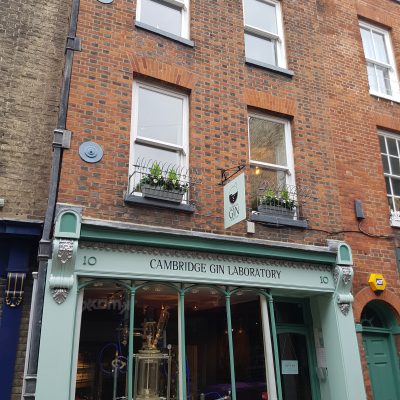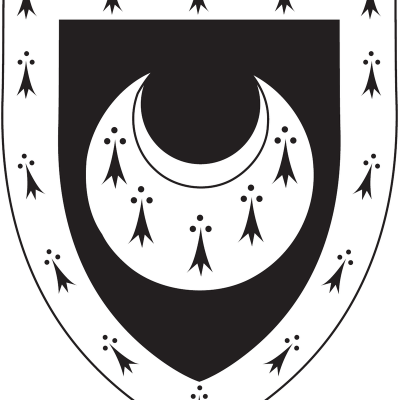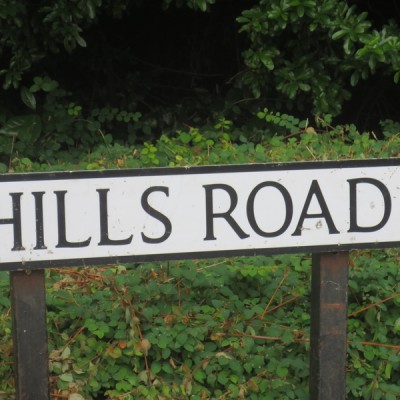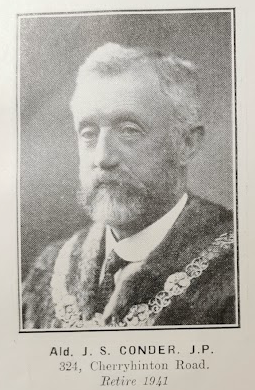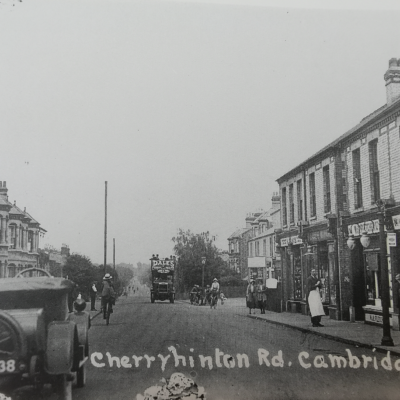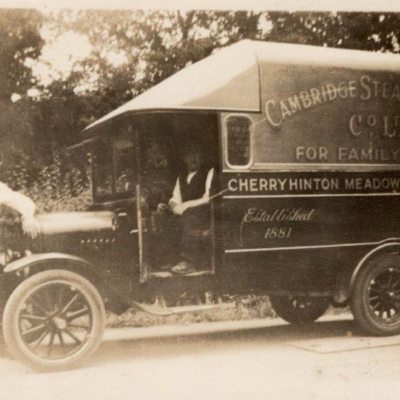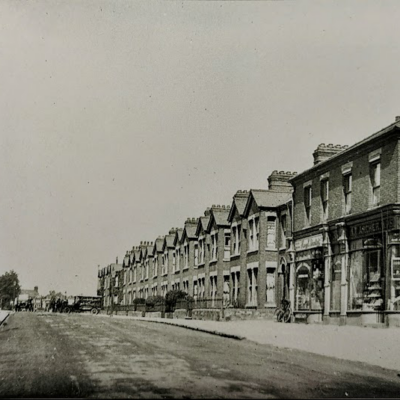Search by topic
- archaeology
- Building of Local Interest
- charity
- church
- crime
- dressmaker
- fire
- Great Eastern Railway
- Listed building
- Mapping Relief
- medieval
- oral history
- poverty
- Public House
- Rattee & Kett
- Religious House
- Roman
- scholar
- school
- Then and Now
- tudor
- women
- work
- world war one
- world war two
Search by text
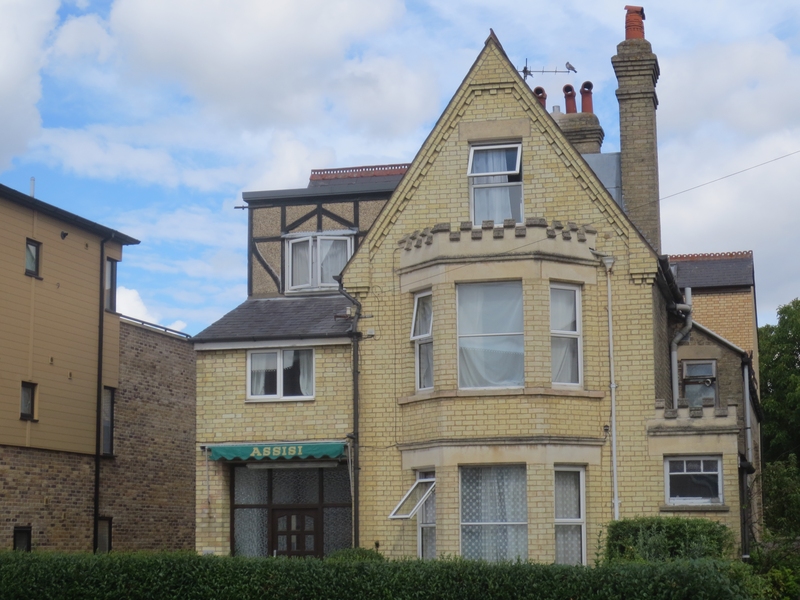 copyright RGL 2016
copyright RGL 2016Bleak House 193 Cherry Hinton Road (Assisi Guest House)
History of Bleak House 193 Cherry Hinton Road
Another of the earliest large houses on Cherry Hinton Road, there was originally a significant gap between this house and Middleton terrace to the west. By 1901 Bleak House was joined by the four Bleak Cottages just to the east.
The census returns show the following residents of Bleak House:
1891
Frederick William Dobson, 32, living on his own means, born Lancs.
Caroline, 38, born Lancs.
May Fry, step daughter, 17, living on her own means, born Lancs.
Charles Fry, step son, student, born Lancs.
Harriet Izzard, 20, servant, born Lancs.
1901 Charles Brooke, 41, clergyman Church of England, author and teacher, born Montreal Canada
Margaret Ling Brook (nee Livermore), 47, author teacher & housewife, born Essex
Winifred, 8, born Middlesex
Charles, 8 mos, born Cherry Hinton
Kate Poole, companion, 40, born London
Rose Parker, 46, servant, born Middlesex
1911
William Godlington, 45, boiler fitter, born Cambridge
Alice, 40, born Cambridge
Constance, 7, born Cambridge
Alexander Fox, boarder, 36, physician and surgeon, born Brighton
Twenty years previously William had been living in Melbourne with his mother and step father working as a whitesmith.
1913 Patrick Flanagan
Charles William Alfred Brooke was born in 1860 in Montreal, Canada. Why his family was in Canada is unclear for the family is in Croydon England in 1871 where his father is a railway clerk, himself born in England. Charles is listed as a student of New College Oxford, matriculating in 1884. In 1891 he is a priest in Tooting. He seems to have written widely on religious and educational topics. The Wellesley Index to Victorian Periodicals 1824-1900 describes him as a writer on education. An on-line search of titles by him uncovers the following:
1896 Eucharistic Hymns not included in A & M. Compiled by Charles W A Brooke
1896 How to teach swimming in class
1902 Brooke, C. W. A. (Charles William Alfred): Alternative hymn tunes : arranged primarily as substitutes for those repeated in Hymns ancient and modern, together with others in constant request / (London : S. Sonnenschein & Co., for the Church Publications Co., 1902)
1911 Brooke, C. W. A. (Charles William Alfred): The Rhaetian Railway : Rh.B. (Rhätische Bahn) : a practical quide to the Swiss highlands of the Grisons / by C.W.A. Brooke and Mrs. M.L. Brooke ; based on the German of Hermann Behrmann. (Chur : Rhaetian Railway Co., 1911). This latter book was written with his wife.
1908 A New Solution … of the Elementary Education Controversy
1914 Brooke, C. W. A. (Charles William Alfred): Companion to Hymns, a. & m. <Old edition> (London, New York [etc.] Sir I. Pitman & sons, ltd., 1914)
1914 Modern Methods of Parochial Organisation
1923 From the Font to Altar. The public administration of Holy Baptism: what it might mean?
Worth School or The Law of Love
Margaret Brooke’s own writings show:
1923 Lace in the Making by M L Brooke illustrated by Winifred M A Brooke.
1911 Winter Life in Switzerland: Its Sports and Health Resorts co-written Margaret and Winifred Brooke.
One reason why he may have moved to Cambridge when he did was the controversy surrounding the court case in 1898. It was reported in the national press (London Evening Standard 24.2.1898) that:
Dr Tristram QC Chancellor of the Diocese of London and Assessors, sat at St Paul’s Chapter House, yesterday, to investigate a charge preferred, under the Clergy Discipline Act of 1892, against the Rev Charles William Alfred Brooke, curate of St Paul’s, Camden Town, who was accused of having sent an objectionable letter to a married woman named Ellen Heard living apart from her husband. … Witnesses were called to prove that, in their opinion, the writing in the communication referred to and genuine letters of the Rev gentleman was the same. On the other hand, Mrs Heard expressed the opnion that the letter was not written by Mr Brooke and the signature was not such as he employed. She absolutely denied that there had been any impropriety between them. Mr Brooke was called, and he corroborated this statement, adding that the letter was not penned by him. In reply to Mr Richards, he admitted that a previous complaint had been made against him, in consequence of which his licence was revoked.
Reynold’s Newspaper (27.2.1989) added that Rev Brooke was a popular worker among coster boys and girls in the King’s Cross district. The lady in question was Nellie Heard, a domestic and the letter had been written in December 1897. the letter had actually been retrieved by a Mr Duguid, a journalist, who lived two doors away from the house where Mrs Heard worked. The journalist showed the letter to Mrs Heard employer who took it to the Bishop of London. Rev. Brooke’s council argued that the letter had been deliberately concocted to discredit him.
The case against Rev Brooke was dismissed in March 1898.
Sources: UK census, British Newspaper Archives, Amazon UK
Contribute
Do you have any information about the people or places in this article? If so, then please let us know using the Contact page or by emailing capturingcambridge@
License
This work is licensed under CC BY-NC-SA 4.0





